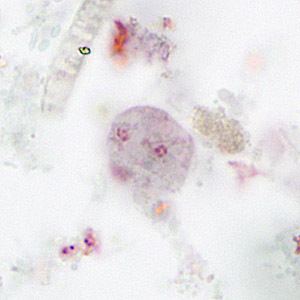Domain Eukaryota Genus Dientamoeba Rank Species | Family Monocercomonadidae Scientific name Dientamoeba fragilis Higher classification Dientamoeba Order Trichomonadida | |
 | ||
Similar Blastocystis, Iodamoeba bütschlii, Endolimax, Entamoeba coli, Entamoeba | ||
What is dientamoeba fragilis
Dientamoeba fragilis is a species of single-celled excavates found in the gastrointestinal tract of some humans, pigs and gorillas. It causes gastrointestinal upset in some people, but not in others. It is an important cause of travellers diarrhoea, chronic diarrhoea, fatigue and, in children, failure to thrive. Despite this, its role as a "commensal, pathobiont, or pathogen" is still debated. D. fragilis is one of the smaller parasites that are able to live in the human intestine. Dientamoeba fragilis are able to survive and move in fresh feces; however are sensitive to aerobic environments. They dissociate when in contact or placed in saline, tap water or distilled water.
Contents
- What is dientamoeba fragilis
- Dientamoeba fragilis
- Etymology
- Dientamoebiasis
- Diagnosis
- Treatment
- Epidemiology
- Phylogenetics
- Build
- References
Dientamoeba fragilis
Etymology
It was first described in 1918.
Dientamoebiasis
There is a continuous debate where D. fragilis is considered to be a harmless organism or a pathogenic parasite. Infection with D. fragilis, called dientamoebiasis, is associated variously with symptoms of abdominal pain, diarrhea, weight loss, nausea, fatigue and fever. In one study, D. fragilis was identified in 0.9% of patients observed. Its coincidence with enterobiasis, caused by E. vermicularis, has been reported. In another study, eosinophilia was present in half of the infected children participating in the case. D. fragilis does not penetrate the host tissue directly; therefore, some of these symptoms may be caused from irritation which then leads to colonic motility. Infection can occur at any age; however, the most common ages that have been reported are children 5-10 years old.
Diagnosis
In order to diagnose the parasite, patients are required to provide (multiple) fresh stool samples that have been preserved for parasite examination. The multiple samples are required because of parasite detection being difficult, therefore, a sample might be obtained each day to help increase the sensitivity. Patients can also be tested for E. vermicularis since the two parasites are known to coincide.
Treatment
Once diagnosed, E. vermicularis is also searched throughout the body. Depending on the age and clinical status of the patient will determine the treatment given. If the patient is a child, a temporary treatment would be offered to test if symptoms can be alleviated, otherwise, another diagnosis and treatment are required. If the child is asymptomatic, then treatment is not necessary. Iodoquinol is the primary drug treatment for dientamoebiasis, unfortunately there are side effects such as abdominal cramping, nausea and rash. There are other medications that treat dientamoebiasis, including paromomyacin, and metronidazole. Tetracycline and doxycycline have also been used as a form of treatment. Drugs such as secnidazole and ornidazole have been used as well, but are not available in the United States.
Epidemiology
Dientamoeba fragilis has an estimated prevalence throughout the United States. Unlike majority of parasitic infections, D. fragilis is more prevalent in well-developed countries as opposed to disadvantaged and resource poor nations. The parasite is also endemic in crowded communities (i.e institutions), populations with unsatisfactory sanitation conditions, and individuals who travel to underprivileged countries. Globally, the prevalence of D. fragilis ranges from 0.3% to 90%, occurring in multiple countries including many urbanized cities such as Los Angeles, California and Sydney, Australia. Recently, D. fragilis was considered to be more prevalent than Giardia, thus leading to better diagnostics.
Phylogenetics
Dientamoeba fragilis is a type of trichomonad. Trichomonads are flagellated organisms but D. fragilis lacks flagella, having secondarily 'lost' them over evolutionary time. Thus, it is an amoeba of flagellate ancestry. In point of ultrastructural and antigenic view, Dientamoeba is reclassified as a flagellate.
The lifecycle of this parasite has not yet been completely determined, but some assumptions have been made based on clinical data. Recently, a cyst stage has been reported, although it is yet to be independently confirmed. If true, D. fragilis is probably transmitted by the fecal-oral route. Prior to the report of this cyst stage in the lifecycle of Dientamoeba, transmission was postulated to occur by helminth eggs (e.g., Ascaris, Enterobius spp.). The rationale for this suggestion was that D. fragilis is closely related to the turkey parasite Histomonas, which is known to be transmitted by the eggs of the helminth Heterakis. Since D. fragilis is known to frequently coinfect with E. vermicularis, this leads to the assumption that E. vermicularis is a possible vector and mode of transmission.
When inside the host, the parasite infects the mucosal crypts of the large intestine. They primarily affect the cecum and proximal colon. It is assumed that when D. fragilis is inside the colon, it reproduces asexually by binary fission. From there the trophozoites are in the lumen of the colon and are excreted as wastes. D. fragilis is not considered to be invasive nor cause cell or tissue damage.
Build
D. fragilis replicates by binary fission, moves by pseudopodia, and feeds by phagocytosis. The cytoplasm typically contains numerous food vacuoles that contain ingested debris, including bacteria. Waste materials are eliminated from the cell through digestive vacuoles by exocytosis. D. fragilis possesses some flagellate characteristics. In the binucleated form is a spindle structure located between the nuclei, which stems from certain polar configurations adjacent to a nucleus; these configurations appear to be homologous to hypermastigotes’ atractophores. A complex Golgi apparatus is seen; the nuclear structure of D. fragilis is more similar to that of flagellated trichomonads than to that of Entamoeba. Also notable is the presence of hydrogenosomes, which are also a characteristic of other trichomonads.
